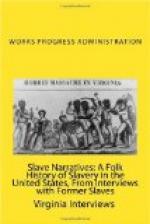“When I passes by de old graveyard on Jackson Street, I ’members lots of folkses whats buried dar, bofe white folkses and slaves too, for den white folkses put dey slaves whar dey aimed to be buried deyselves. Dat sho’ used to be a fine graveyard.
“Us all gwine to git together someday when us all leaves dis old world. I’m ready to go; jus’ a-waitin’ for de Lord to call me home, and I ain’t skeered to face de Lord who will judge us all de same, ’cause I done tried to do right, and I ain’t ’fraid to die.”
Uncle Willis was tired and sent a little boy to the store for milk. As the interviewer took her departure he said: “Good-bye Missy. God bless you. Jus’ put yourself in de hands of de Lord, for dey ain’t no better place to be.”
PLANTATION LIFE
Mary Colbert, Age 84 168 Pearl Street Athens, Georgia
Written by:
Sadie B. Hornsby [HW: (White)]
Athens
Edited by:
Sarah H. Hall
Athens
and
John N. Booth
District Supervisor
Federal Writers’ Project
Residencies 6 & 7
Augusta, Ga.
(Note: This is the first story we have had in which the client did not use any dialect. Mary Colbert’s grammar was excellent. Her skin was almost white, and her hair was quite straight.
None of us know what a “deep” slave was. It may have the same meaning as outlandish Negro. The “outlandish Negroes” were those newly arrived Negroes who had just come in from any country outside of the United States of America, and were untrained. They were usually just from Africa.
Sarah H. Hall)
With the thermometer registering 93 degrees in the shade on a particularly humid July day, the visitor trudged up one steep, rocky alley and down another, hesitantly negotiated shaky little bridges over several ravines, scrambled out of a ditch, and finally arrived at the address of Mary Colbert. It was the noon hour. A Negro man had tied his mule under an apple tree in one corner of Mary’s yard. The animal was peacefully munching hay while his master enjoyed lunch from a battered tin bucket. Asked if Mary was at home, the man replied: “Yessum, jus’ call her at de door.”
A luxuriant Virginia creeper shaded the front porch of Mary’s five-room frame house, where a rap on the front door brought the response: “Here I am, honey! Come right on through the house to the back porch.” The aged mulatto woman was hanging out clothes on a line suspended between two peach trees. To the inquiry for Mary, she answered: “Yes, Honey, this is Mary. They say I am old, childish, and hellish; anyway, this is Mary.”




